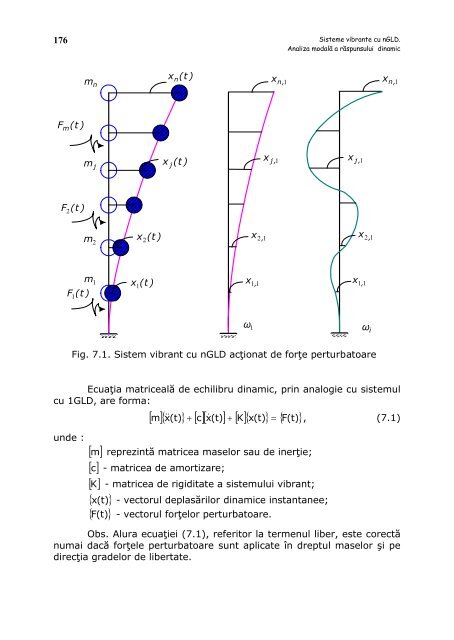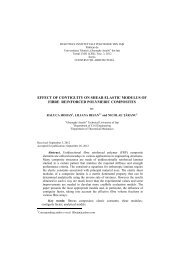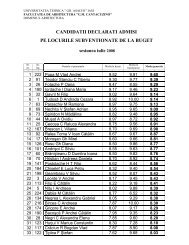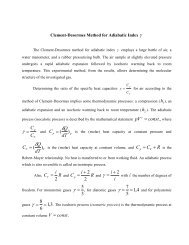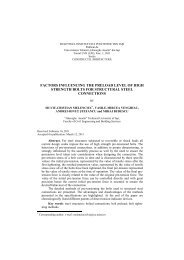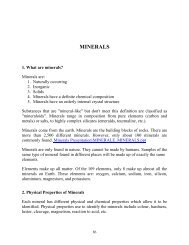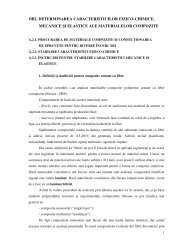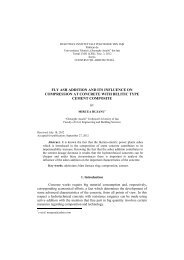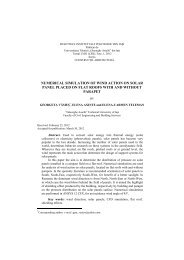- Page 1:
CONSTANTIN IONESCU STABILITATEA ŞI
- Page 4 and 5:
4 Cuprins 3.4. Vibraţii forţate p
- Page 6 and 7:
1.1.Generalităţi CAPITOLUL 1 STAB
- Page 8 and 9:
8 Stabilitatea şi Dinamica Constru
- Page 10 and 11:
10 1.2.4. Modelarea sistemelor Stab
- Page 12 and 13:
12 Stabilitatea şi Dinamica Constr
- Page 14 and 15:
14 1.2.6. Sistem dinamic (vibrant)
- Page 16 and 17:
16 a. m k a. m k x(t) x(t) c 1GLD b
- Page 18 and 19:
18 Stabilitatea şi Dinamica Constr
- Page 20 and 21:
20 Stabilitatea şi Dinamica Constr
- Page 22 and 23:
22 a. x(t) F(t) m b. u(t) Sisteme c
- Page 24 and 25:
24 b. pentru situaţia aplicării i
- Page 26 and 27:
26 Sisteme cu un grad de libertate
- Page 28 and 29:
28 Sisteme cu un grad de libertate
- Page 30 and 31:
30 a. b. m a. k ∆ =1 b. k m MS
- Page 32 and 33:
32 Sisteme cu un grad de libertate
- Page 34 and 35:
34 ∗ Sisteme cu un grad de libert
- Page 36 and 37:
36 Sisteme cu un grad de libertate
- Page 38 and 39:
38 1.1.3 1.1.2 1 EI=const 1.1.5. m
- Page 40 and 41:
40 Probleme rezolvate. Sisteme cu 1
- Page 42 and 43:
42 1/2 ω = 1 mδ l/2 − Probleme
- Page 44 and 45:
44 Aplicaţia 1.3 (fig.1.3) 1. Tras
- Page 46 and 47:
46 nodul 1: α 1 V1=1/3 nodul 2: 1
- Page 48 and 49:
48 nodul 7: ⎧ ⎪∑ x = 0; ⎨
- Page 50 and 51:
50 b) forţa elastică c) forţa pe
- Page 52 and 53:
52 m( ω F 0 2 Sisteme vibrante cu
- Page 54 and 55:
54 xF ( t) Sisteme vibrante cu 1GLD
- Page 56 and 57:
56 sau Fd i ( t) = F ( t) + F( t) S
- Page 58 and 59:
58 unde şi x ( t) j = ∑ n * µ k
- Page 60 and 61:
60 2.2. 2.3. 2.4 Problema 2.2 EI=co
- Page 62 and 63:
62 Breviar teoretic 1. Forţe Probl
- Page 64 and 65:
64 Probleme rezolvate. Sisteme cu 1
- Page 66 and 67:
66 Probleme rezolvate. Sisteme cu 1
- Page 68 and 69:
68 7.59156⋅10 4 4.436875⋅10 4 N
- Page 70 and 71:
70 2 K34 d34 = = 0, 6 K Probleme re
- Page 72 and 73:
72 6.27166⋅10 4 2.448⋅10 4 Fig.
- Page 74 and 75:
74 δ ss δ ss = δ 11 + 2δ Calcul
- Page 76 and 77:
76 3. Determinarea răspunsului în
- Page 78 and 79:
78 X(t) ϕ/ω=0.01782 s x0ω 2 Apli
- Page 80 and 81:
80 X(t) ϕ/ω Rezolvare µ * F0δ
- Page 82 and 83:
PROBLEME PROPUSE 1 SISTEME CU 1GLD
- Page 84 and 85:
84 m Probleme propuse. Sisteme cu 1
- Page 86 and 87:
86 Fig. 1.10 F( t) = F0 sin θt Pro
- Page 88 and 89:
88 a. b. c. d. y1( t ) I1 ( t ) y1(
- Page 90 and 91:
90 ⎡ δ11 δ12 . δ1j . δ1n ⎤
- Page 92 and 93:
92 λ n + a n−1 1 λ + ....... +
- Page 94 and 95:
94 [ Ω] ⎡ω ⎢ ⎢ ⎢ = ⎢
- Page 96 and 97:
96 ⎧ 1 ⎫ y 1 = ⎨ ⎬ şi {} y
- Page 98 and 99:
98 c. d. 1, 1 d. 1, 1 δ1 j δ41 δ
- Page 100 and 101:
100 1,1 1,1 a. b. c 1 l 1 1,1 l 1 l
- Page 102 and 103:
CAPITOLUL 5 SISTEME VIBRANTE CU nGL
- Page 104 and 105:
104 Sisteme vibrante cu nGLD. Vibra
- Page 106 and 107:
106 2 [ K] − ω [ m] ) { A} = { 0
- Page 108 and 109:
108 Sisteme vibrante cu nGLD. Vibra
- Page 110 and 111:
110 Dacă folosim matricea modală,
- Page 112 and 113:
112 5.6.1. Folosirea metodei forţe
- Page 114 and 115:
114 a. c. 2 R1p K Z1 Z2 K 2 R2p Z3
- Page 116 and 117:
116 ⎧y⎫ ⎨ ⎬ ⎩θ⎭ [ r ]{
- Page 118 and 119:
118 3.4 1 3.3 2EI 0.5l m2 Probleme
- Page 120 and 121:
120 [ ∆] ⎡δ11 ⎢ ⎢ δ21 ⎢
- Page 122 and 123:
122 εr % = det( Probleme rezolvate
- Page 124 and 125:
124 Probleme rezolvate. Sisteme cu
- Page 126 and 127: 126 δ 11 Probleme rezolvate. Siste
- Page 128 and 129: 128 εa εr % = ⎛ 3 ml ⎞ 94⎜
- Page 130 and 131: 130 2. Determinarea matricei de fle
- Page 132 and 133: 132 Probleme rezolvate. Sisteme cu
- Page 134 and 135: 134 şi matricea de flexibilitate d
- Page 136 and 137: 136 a. c. 1. 3265 2. 4458 e. y , 2
- Page 138 and 139: 138 Matricea de flexibilitate se co
- Page 140 and 141: 140 Probleme rezolvate. Sisteme cu
- Page 142 and 143: 142 6EI 2 a a. 6EI 2 a c. 4EI a f.
- Page 144 and 145: 144 Probleme rezolvate. Sisteme cu
- Page 146 and 147: CAPITOLUL 6 SISTEME VIBRANTE CU nGL
- Page 148 and 149: STABILITATEA ŞI DINAMICA CONSTRUC
- Page 150 and 151: STABILITATEA ŞI DINAMICA CONSTRUC
- Page 152 and 153: STABILITATEA ŞI DINAMICA CONSTRUC
- Page 154 and 155: STABILITATEA ŞI DINAMICA CONSTRUC
- Page 156 and 157: STABILITATEA ŞI DINAMICA CONSTRUC
- Page 158 and 159: STABILITATEA ŞI DINAMICA CONSTRUC
- Page 160 and 161: STABILITATEA ŞI DINAMICA CONSTRUC
- Page 162 and 163: STABILITATEA ŞI DINAMICA CONSTRUC
- Page 164 and 165: STABILITATEA ŞI DINAMICA CONSTRUC
- Page 166 and 167: STABILITATEA ŞI DINAMICA CONSTRUC
- Page 168 and 169: STABILITATEA ŞI DINAMICA CONSTRUC
- Page 170 and 171: STABILITATEA ŞI DINAMICA CONSTRUC
- Page 172 and 173: PROBLEME PROPUSE 2 SISTEME CU n GLD
- Page 174 and 175: STABILITATEA ŞI DINAMICA CONSTRUC
- Page 178 and 179: STABILITATEA ŞI DINAMICA CONSTRUC
- Page 180 and 181: STABILITATEA ŞI DINAMICA CONSTRUC
- Page 182 and 183: STABILITATEA ŞI DINAMICA CONSTRUC
- Page 184 and 185: STABILITATEA ŞI DINAMICA CONSTRUC
- Page 186 and 187: STABILITATEA ŞI DINAMICA CONSTRUC
- Page 188 and 189: STABILITATEA ŞI DINAMICA CONSTRUC
- Page 190 and 191: 9.1. Grinda încastrată CAPITOLUL
- Page 192 and 193: STABILITATEA ŞI DINAMICA CONSTRUC
- Page 194 and 195: STABILITATEA ŞI DINAMICA CONSTRUC
- Page 196 and 197: STABILITATEA ŞI DINAMICA CONSTRUC
- Page 198 and 199: STABILITATEA ŞI DINAMICA CONSTRUC
- Page 200 and 201: STABILITATEA ŞI DINAMICA CONSTRUC
- Page 202 and 203: STABILITATEA ŞI DINAMICA CONSTRUC
- Page 204 and 205: STABILITATEA ŞI DINAMICA CONSTRUC
- Page 206 and 207: STABILITATEA ŞI DINAMICA CONSTRUC
- Page 208 and 209: STABILITATEA ŞI DINAMICA CONSTRUC
- Page 210 and 211: STABILITATEA ŞI DINAMICA CONSTRUC
- Page 212 and 213: STABILITATEA ŞI DINAMICA CONSTRUC
- Page 214 and 215: STABILITATEA ŞI DINAMICA CONSTRUC
- Page 216 and 217: STABILITATEA ŞI DINAMICA CONSTRUC
- Page 218 and 219: STABILITATEA ŞI DINAMICA CONSTRUC
- Page 220 and 221: CAPITOLUL 11 CALCULUL DE STABILITAT
- Page 222 and 223: STABILITATEA ŞI DINAMICA CONSTRUC
- Page 224 and 225: STABILITATEA ŞI DINAMICA CONSTRUC
- Page 226 and 227:
STABILITATEA ŞI DINAMICA CONSTRUC
- Page 228 and 229:
STABILITATEA ŞI DINAMICA CONSTRUC
- Page 230 and 231:
STABILITATEA ŞI DINAMICA CONSTRUC
- Page 232 and 233:
STABILITATEA ŞI DINAMICA CONSTRUC
- Page 234 and 235:
STABILITATEA ŞI DINAMICA CONSTRUC
- Page 236 and 237:
STABILITATEA ŞI DINAMICA CONSTRUC
- Page 238 and 239:
STABILITATEA ŞI DINAMICA CONSTRUC
- Page 240 and 241:
STABILITATEA ŞI DINAMICA CONSTRUC
- Page 242 and 243:
STABILITATEA ŞI DINAMICA CONSTRUC
- Page 244 and 245:
STABILITATEA ŞI DINAMICA CONSTRUC
- Page 246 and 247:
STABILITATEA ŞI DINAMICA CONSTRUC
- Page 248 and 249:
STABILITATEA ŞI DINAMICA CONSTRUC
- Page 250 and 251:
STABILITATEA ŞI DINAMICA CONSTRUC
- Page 252 and 253:
STABILITATEA ŞI DINAMICA CONSTRUC
- Page 254 and 255:
STABILITATEA ŞI DINAMICA CONSTRUC
- Page 256 and 257:
STABILITATEA ŞI DINAMICA CONSTRUC
- Page 258 and 259:
STABILITATEA ŞI DINAMICA CONSTRUC
- Page 260 and 261:
STABILITATEA ŞI DINAMICA CONSTRUC
- Page 262 and 263:
STABILITATEA ŞI DINAMICA CONSTRUC
- Page 264 and 265:
CAPITOLUL 14 CALCULUL DE ORDINUL II
- Page 266 and 267:
STABILITATEA ŞI DINAMICA CONSTRUC
- Page 268 and 269:
STABILITATEA ŞI DINAMICA CONSTRUC
- Page 270 and 271:
STABILITATEA ŞI DINAMICA CONSTRUC
- Page 272 and 273:
STABILITATEA ŞI DINAMICA CONSTRUC
- Page 274 and 275:
STABILITATEA ŞI DINAMICA CONSTRUC
- Page 276 and 277:
STABILITATEA ŞI DINAMICA CONSTRUC
- Page 278 and 279:
STABILITATEA ŞI DINAMICA CONSTRUC
- Page 280 and 281:
STABILITATEA ŞI DINAMICA CONSTRUC
- Page 282 and 283:
STABILITATEA ŞI DINAMICA CONSTRUC
- Page 284 and 285:
STABILITATEA ŞI DINAMICA CONSTRUC
- Page 286 and 287:
STABILITATEA ŞI DINAMICA CONSTRUC
- Page 288 and 289:
BIBLIOGRAFIE B 1. Bănuţ, V., Calc
- Page 290 and 291:
STABILITATEA ŞI DINAMICA CONSTRUC


